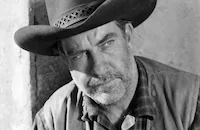College
Brief Synopsis
Cast & Crew
James W. Horne
Buster Keaton
Anne Cornwall
Flora Bramley
Harold Goodwin
Buddy Mason
Film Details
Technical Specs

Synopsis
The Boy graduates from high school with interscholastic honors, and as class orator he speaks on "Brains vs. Brawn," demeaning athletics, thereby winning the favor of the pedagogs but not that of the students. His college sweetheart requires that he become an athlete, so he spends his savings and tries out for all sports and is a perfect flop. He goes to work to pay his way through school, but every job adds to his blunders. His rival takes delight in maneuvering The Girl to his place of employment and further humiliating him. Then the college dean takes an interest in The Boy and insists that the varsity coach give him a chance; through coincidence, he thwarts a plot against him and wins a race. Learning that his rival has locked The Girl in the dormitory, The Boy goes to the rescue, performing all the athletic feats he dreamed about, and knocks the rival cold; thus the weakling becomes the college idol.

Director
James W. Horne
Cast

Buster Keaton
Anne Cornwall
Flora Bramley
Harold Goodwin
Buddy Mason

Grant Withers
Snitz Edwards
Carl Harbaugh
Sam Crawford
Florence Turner
Paul Goldsmith
Morton Kaer
Bud Houser
Kenneth Grumbles
Charles Borah
Leighton Dye
Lee Barnes
"shorty" Worden
Robert Boling
Erick Mack
University Of Southern California Baseball Team
Crew

Photo Collections
Videos
Movie Clip




Film Details
Technical Specs

Articles
College
The result was College (1927). At that time, America was college crazy with collegiate songs filling the airwaves along with college football games, college slang and collegiate fashion styles. In addition, fellow screen comedian Harold Lloyd had his biggest success with the college comedy The Freshman (1925). Putting the stone-faced Keaton in a university setting seemed like a natural.
The movie's plot has Buster Keaton playing Ronald, the most academically successful student in high school and the 1920's equivalent of a "nerd." "Anyone prefers an athlete to a weak-kneed teacher's pet," his girl tells him. When the high school gang arrives at college, the physically inept Ronald must find a way to prove his manhood on the sporting field or lose his girl.
The storyline is ironic as Keaton was probably the most athletic comedian of all time. Obsessed with baseball, Keaton would halt production on his movies to squeeze in a quick game with his crew. However, he did have to limit his physical prowess slightly on this film. For a scene where Ronald pole-vaults through a window, Keaton had to use a stunt double (Lee Barnes) for the first time in his career. "I could not do the scene because I am no pole-vaulter and I didn't want to spend months in training to do the stunt myself."
There were more unfortunate firsts behind the scenes. Keaton's usual producer, Joseph Schenck, had just become the president of United Artists and was too busy to oversee the production. In his place, Schenck put his publicity chief Harry Brand who badgered Keaton throughout the shoot about costs and seized a special "Supervised by Harry Brand" screen credit that irritated Keaton. Nevertheless, Keaton remained persistent in his attention to detail. For example, Harold Goodwin, who plays the villain in College, recalled Keaton "trying to bounce a football off his skull several hundred times before finally admitting that it couldn't be done." (From Keaton: The Man Who Wouldn't Lie Down by Tom Dardis).
College may have seemed a sure bet, but critics at the time were lukewarm such as Variety which noted, "they'll laugh at College, but it will go down as just another program comedy resting for its pull on the excellent things Keaton has done before, rather than building on its own merits." Audiences took the hint and made College an even bigger flop than The General.
Keaton would make one more picture on his own, Steamboat Bill, Jr. (1928), before departing for MGM and the end of his classic comedy movies. Now, with College, we see not only a great comic film, but a puzzle. Why couldn't audiences of the 1920's appreciate Keaton's movies?
Producer: Joseph M. Schenck
Director: James W. Horne
Screenplay: Bryan Foy, Carl Harbaugh
Cinematography: Bert Haines, Devereaux Jennings
Film Editing: Sherman Kell
Cast: Buster Keaton (Ronald), Anne Cornwall (The Girl), Flora Bramley (Her Friend), Harold Goodwin (A rival), Snitz Edwards (The Dean), Carl Harbaugh (Crew Coach).
BW-65m.
by Brian Cady

College
Quotes
Trivia
The boat for which Buster Keaton is coxswain is called Damfino, the same name as the eponymous boat in his short movie Boat, The (1921).
The pole vault near the end of the movie is one of the few stunts in his career that Keaton did not perform himself.
Various sources associated with the production recalled in later interviews that there was also a filmed scene of Keaton's character trying to play football, but that this scene was later removed to avoid too close a comparison with Harold Lloyd's Freshman, The (1925). While no film has surfaced to confirm this, two small parts of the released film lend credence it: 1) When Keaton is unpacking in his dorm, one of the how-to-play-sports books he unpacks is about football, and 2) in the scene of Keaton running across the campus to rescue his girl, he dodges through a crowd of people like a running back trying to avoid tacklers in the open field.













